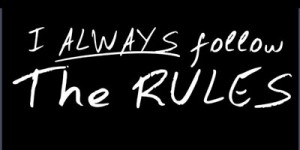 Hi! I’m back! I hope you learned a lot from Laurie’s posts of the past couple of weeks.
Hi! I’m back! I hope you learned a lot from Laurie’s posts of the past couple of weeks.
Now it’s time to get back to something that I love very much: the rules.
Last time I wrote here, I covered the different types of editing that an editor might be required to perform on your manuscript. One of my favorites is copyediting. That’s because I’m a stickler for rules. Things need to have rules, and they need to adhere to those rules as much as possible.
Unfortunately, language is really bad about rules. All languages are fluid, ever-changing. Definitions of words change as we use them in different connotations (I mean, like, literally). New words crop up to describe new experiences and developments (have you Googled anything today?). And hey, that’s great. I mean, who wants to talk like Chaucer anyway? “Whan that Aprille…” Please. So five centuries ago.
And that’s not even talking about the mess of languages we call English. English was already a hodge-podge of Germanic and Romantic languages. But over the years, as the world has shrunk and we’ve all kind of mushed together in America, words from other languages have pushed their way in (tête-à-tête, anyone? Know any business tycoons?). These have made huge exceptions to whatever semblance of rules we might have had.
So, in this world where dictionaries tell us that both analyse and analyze are acceptable and where no one can decide whether or not to keep the Oxford comma, how do we choose? How can the rule-keepers keep some order among the chaos?
Style Guides Everywhere!
I first noticed that there were different style guides in college. I was in the English department, and my professors insisted I acquaint myself with MLA formatting for everything I turned in. My sister, a Family Studies/Child Development major, used APA. And in my Bible classes, my professors didn’t care what style I used as long as I was consistent (you can imagine my outrage when one of my teachers accused me of making a style up when I was clearly using MLA).
Style Guides are what keep us sane (sometimes). There are a lot of styles to choose from, and most guides are specific to different venues and purposes. For example, MLA is for literary articles, while APA is mostly used for psychology journals and the like. Turabian is used for theses and dissertations.
Imagine my shock when I discovered that the Little, Brown Handbook was neither little nor brown, but a rather robust guide for the rules in multiple styles of citation. There are so many different style guides out there that I can’t begin to cover them all. I had an editor friend where one of her authors insisted that she use the University of Alaska Fairbanks‘ style guide for editing her novel.
Chicago Manual of Style
 But please don’t feel overwhelmed. If you’re writing a novel or even non-fiction book, the choice is simple. The majority of publishing houses in the United States use Chicago Manual of Style, and so should you.
But please don’t feel overwhelmed. If you’re writing a novel or even non-fiction book, the choice is simple. The majority of publishing houses in the United States use Chicago Manual of Style, and so should you.
CMOS (as we in the biz like to call it) covers everything from how to space the lines in your document to whether or not to add hyphens in black-and-white (hint, the answer is do add them). When Merriam-Webster and the OED give you two different ways spell something, Chicago can make the decision of which to choose (it’s Merriam-Webster, btw).
The size of this tome may intimidate you, but it makes me feel safe. Each page is chock full of rules for me to follow!
CMOS actually gives you a lot of places where you, the author, can use “your best judgement,” as long as you are consistent with your usage. It also has an online forum where you can ask questions that are answered by the editors.
If you don’t have the money to splurge on a new footrest *cough* I mean, very useful guide book that you will use every day *cough*, or decide to go with a different guide book, that’s fine with me. I’ll never know the difference. But this is the most important rule, and you must follow it at all costs:
Be consistent.
No matter what, always be consistent with the rules that you set for yourself. If you don’t, you look sloppy and like you don’t care about your work. Consistency shows that you have meticulously read through your work for errors, that you understand what you are doing, and that you have enough discipline to follow through. Consistency is key!
But really, just use CMOS. It’s the best.






